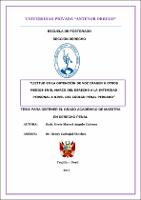Mostrar el registro sencillo del ítem
Licitud en la obtención de voz, imagen u otros medios en el marco del derecho a la intimidad personal a nivel del Código Penal Peruano
| dc.contributor.advisor | Carbajal Sánchez, Henry | |
| dc.contributor.author | Angulo Cabrera, Grety Mayeci | |
| dc.creator | Angulo Cabrera, Grety Mayeci | |
| dc.date.accessioned | 2017-01-30T20:19:09Z | |
| dc.date.available | 2017-01-30T20:19:09Z | |
| dc.date.issued | 2016 | |
| dc.identifier.uri | https://hdl.handle.net/20.500.12759/2261 | |
| dc.description.abstract | La Tesis denominada “Licitud en la obtención de voz, imagen u otros medios en el marco del derecho a la intimidad personal a nivel del Código Penal Peruano”, responde a la necesidad de determinar la fundamentación jurídico doctrinaria de la licitud de la obtención no autorizada de voz, imagen por cualquier medio en el marco del derecho a la intimidad personal en relación con el delito de violación de la intimidad tipificado en el artículo 154 del Código Penal Peruano, y establecer los efectos jurídicos del uso de grabaciones de voz, imagen por cualquier medio, en la figura de intimidad personal y su relación con el interés público y su contribución a la sociedad. En este sentido, la formulación de nuestro problema fue el siguiente: ¿En qué medida, de manera excepcional será lícita la obtención no autorizada de una grabación de voz o imagen por cualquier medio, sin que constituya el delito de violación de la intimidad tipificado en el artículo 154 del Código Penal Peruano?, para lo cual proponemos la siguiente hipótesis: En la medida que la obtención no autorizada de grabación de voz o imagen por cualquier medio, resulten razonables y de interés público, su obtención de manera excepcional será licita, sin constituir delito de violación de la intimidad tipificado en el artículo 154 del Código Penal Peruano. En este orden de ideas, nos abocamos al estudio de la Doctrina, Legislación y Jurisprudencia para demostrar dicha hipótesis, dado que, si bien es cierto, implica una intromisión a la esfera privada de las personas, no obstante, es de advertir que nuestro trabajo justifica dicha intromisión, siempre cuando la información que se logre obtener sean de interés público y beneficien a la colectividad. De esta forma se ha logrado concluir que los supuestos por los cuales se puede justificar la licitud en la obtención no autorizada de voz o imagen por cualquier medio, sin que constituya delito de la violación de la intimidad personal tipificado en el Artículo 154 del Código Penal, se presentan cuando la información conseguida es relevante por su contribución a la sociedad y manifiesta interés público. | es_PE |
| dc.description.abstract | The thesis called ““Legality in obtaining voice, images or other means within the framework of the right to personal privacy level Peruvian Penal Code““, responds to the need to determine the doctrinaire legal basis for the legality of obtaining unauthorized voice, image by any means under the right to privacy in relation to the crime of violation of privacy as defined in Article 154 of the Peruvian Penal Code, and establish the legal effects of the use of voice recording, image for any means, in the form of personal privacy and their relationship with the public interest and their contribution to society. In this sense, the formulation of our problem was: To what extent, exceptionally be lawful obtaining unauthorized recording voice or image by any means, without constituting the crime of violation of privacy typified in Article 154 of the Peruvian Penal Code ?, for which we propose the following hypothesis: to the extent that obtaining unauthorized recording voice or image by any means, are reasonable and public interest, their production is exceptionally tender, without constituting crime of violation of privacy as defined in Article 154 of the Peruvian Penal Code. In this vein, we apply ourselves to the study of the Doctrine, Legislation and Jurisprudence to prove this hypothesis, since, if it is true, involves an intrusion into the private sphere of individuals, however, it is noted that our work justify such interference, as long as the information gained obtained are of public interest and benefit to the community. Thus has been achieved to conclude that the assumptions by which they can justify the legality obtaining unauthorized voice or image by any means, without constituting crime of violation of personal privacy as defined in Article 154 of the Penal Code , they occur when the information gathered is relevant for their contribution to society and manifest public interest. | en_US |
| dc.description.uri | Tesis | es_PE |
| dc.format | application/pdf | es_PE |
| dc.language.iso | spa | es_PE |
| dc.publisher | Universidad Privada Antenor Orrego - UPAO | es_PE |
| dc.relation.ispartofseries | T_MAEST.DERE_065 | |
| dc.rights | info:eu-repo/semantics/openAccess | es_PE |
| dc.source | Universidad Privada Antenor Orrego | es_PE |
| dc.source | Repositorio Institucional - UPAO | es_PE |
| dc.subject | Derecho a la intimidad | es_PE |
| dc.subject | Nivel del Codigo Penal Peruano | es_PE |
| dc.title | Licitud en la obtención de voz, imagen u otros medios en el marco del derecho a la intimidad personal a nivel del Código Penal Peruano | es_PE |
| dc.type | info:eu-repo/semantics/masterThesis | es_PE |
| thesis.degree.level | Maestría | es_PE |
| thesis.degree.grantor | Universidad Privada Antenor Orrego. Escuela de Postgrado | es_PE |
| thesis.degree.name | Maestro en Derecho con Mención en Derecho Penal | es_PE |
| thesis.degree.discipline | Maestría en Derecho | es_PE |

